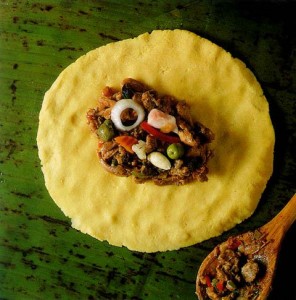Fond Farewells and Serendipitous Surprises
Our contented field has been lapping up the rain since last Wednesday. Silvery ribbons of droplets descending from the heavens have satiated the field with a generous outpouring of amazing aqua. Our joy is as plentiful as the puddles! The vegetables are growing vigorously, indulging in the joy of November rains, when the temperatures are not yet too low, the rain is plentiful, and the occasional sunbeam still glitters.
Last week we picked the last of our corn. Sadly but acceptingly, we bade farewell to Chubeza’s only grain, our summer’s sweet dessert. When we sealed last Wednesday’s boxes, I thought this was the last we’d see of the corn. But the next morning I was surprised by a rainy Chubeza tale which I shall share with you:
On Thursday, I got a phone call from Katy from Jerusalem. Katy is a veteran client, and a cook who hails from South America. This winning combination brought her to open the catering business Smells Good, specializing in Latin American food. She had a quick question: how could she obtain banana leaves? Could we possibly supply her with them or refer her to a banana farmer? I sent her to our neighbor and colleague Hilaf, but she needed a larger quantity than he could supply. Yet Katy did not despair. Instead, the intrepid chef decided to substitute corn husks for the elusive banana leaves.
She needed these in order to make “Hallacas,” a Venezuelan food traditionally served at the Christmas meal, and a beloved winter staple. The dish consists of a stuffed corn flour pastry filled with a mixture of ground meat, green pepper, onion, olives, raisins, almonds and capers, wrapped in a banana leaf (plantain) and steamed. The whole family takes part in preparing the Hallacas, with the cooking accompanied by music and drinking, and lots of stories and songs. The stuff that memories are made of, each winter.
This is how the Hallacas looks in preparation:
There is real logic in substituting corn husks for the banana leaves, as this dish is the sister, or at least the cousin, of the Mexican tamale, a popular dish of cornmeal dough steamed in corn husks. This is probably the origin of the Hallacas, but over the years many colorful tales have emerged to describe the birth of Hallacas, traditionally told and retold during its preparation. The most popular legend purports that Hallacas were created by slaves during the colonial times. In those days, the slaves used leftovers from their master’s Christmas feast to place in a bit of cornmeal dough. Then they would wrap them with banana leaves and boil to blend the flavors. Another tale narrates the toil of the native workers who built the “Cerro El Ávila” to the nearby port of La Guaira, feasting on tamales prepared from cornmeal. However, during the construction project to improve the road, the Indians workers began dying en masse from diseases caused by vitamin deficiencies. The Caracas families then donated from their meat and vegetable dishes in order to fortify the workers’ diet.
Meanwhile, back to Israel 2011 and rainy Jerusalem: I told Katy we could give her a couple hundred corn husks, but only the next day, and that she would have to pick them herself as we were working in-house due to the rain. Katy replied that she’d make one more stab at procuring banana leaves from the market. If unsuccessful, we would talk the next day. On Friday morning, she informed me that banana leaves were no longer an option, and she was going for the corn husks. Later in the afternoon, I guided her and her husband David by phone to the edge of our wet field. I wished them a successful harvest, and warned them not to try to drive into the field, as their car is liable to sink.
Katy wrote today to thank me for the corn-husks-that-saved-the-day. I asked for full details as to how they managed to pick between the raindrops. Her response: “It was beautiful!!!!!” Even via e-mail, her excitement and wonder came through loud and clear. Our corn is truly a wonder, and once again it surprised us all by giving a lovely farewell gift at the end of autumn.
May we all have wonderful days, after the blessed and abundant rain that brings joy to our hearts. And don’t be too sad about bidding adieu to the corn. The cauliflower, broccoli and kohlrabi are already here!
Alon, Bat Ami and the Chubeza team
___________________________________
What’s in our After-the-Rain Boxes? Lottttttts of Mud, Plus:
Monday: Baby potatoes, beets, red mustard, scallions, cauliflower, tomatoes, sweet red peppers, parsley, carrots, radishes, lettuce
In the large box, in addition: Cowpeas (lubia) or yard-long beans or peas or eggplant, arugula, kohlrabi
Wednesday: arugula, lettuce, cucumbers, parsley, scallions, beets, red bell peppers, Swiss chard or kale, tomatoes, carrots, daikon.
In the large box, in addition: cabbage or cauliflower or broccoli, mustard greens, baby potatoes
___________________________
Recipes:
The first recipe, Vegan Hallacas, calls for seitan, a wheat gluten similar to tofu. It’s fine to substitute tofu for the seitan:
In the next recipe for festive Hallacas, feel free to ignore the pork, a staple element of the Venezualan diet.
To inaugurate the start of the radish season, Ornit sent me this recipe for Pickled Radishes (you can try it with daikon too):
From your responses, I see that it’s time to refresh your knowledge of how to prepare those tangy, healthy mustard greens that are filling your boxes.


